Hemolytic anemia
Anemia is a condition in which the body does not have enough healthy red blood cells. Red blood cells provide oxygen to body tissues.
Anemia
Anemia is a condition in which the body does not have enough healthy red blood cells. Red blood cells provide oxygen to body tissues. Different type...

Normally, red blood cells last for about 120 days in the body. In people with hemolytic anemia, red blood cells in the blood are destroyed earlier than normal.
Causes
Anemia - Animation
Do you feel tired and listless? Do you find your mind drifting during the day? Do you get dizzy or short of breath whenever you climb the stairs? There are a few possible reasons for the way you feel, but you could have anemia. You could even have anemia without noticing any symptoms at all. Anemia is a problem with hemoglobin, a substance in red blood cells that carries oxygen throughout your body. Without enough hemoglobin, your heart and other organs can't get the oxygen they need to work. When your organs slow down, you slow down and you start feeling tired and listless. Many different health conditions can cause anemia, from heavy blood loss during a woman's period, to pregnancy, to an underactive thyroid gland. Healthy red blood cells are made in your bone marrow, the soft tissue in the middle of your bones. Any disease that damages blood marrow, such as lymphoma or leukemia, can also affect your red blood cell production. Anemia can also be caused by an immune system problem that damages red blood cells, or surgery to the stomach or intestines. How do you know if you have anemia? You may feel tired, dizzy, and have trouble concentrating. You may get sick more often. People with anemia often complain of chest pain, headaches, or shortness of breath. Your skin might look pale, like you haven't seen the sun for months. Because these can also be symptoms of other conditions, your doctor will confirm that you have anemia by taking a blood test to check your red blood cell count and hemoglobin level. Blood tests can also look for problems that may be causing your anemia, such as a vitamin or iron deficiency. If you are anemic, it's very important to treat it. When your body isn't getting enough oxygen, it can starve vital organs like your heart. This can lead to a heart attack. How you treat anemia really depends on the cause. If the problem is with your bone marrow, you may take a medicine called erythropoietin, which will help your bone marrow make more red blood cells. If the problem is a vitamin or mineral deficiency, your doctor may prescribe iron, vitamin B12, or folic acid supplements. Or, you may need a blood transfusion to replace damaged red blood cells with healthy ones. How well you do really depends on what's causing your anemia. Call your doctor if you have any symptoms like fatigue or shortness of breath. Once your doctor can find and treat the cause of your anemia, you should have more energy and start feeling like your old self again.
The bone marrow is mostly responsible for making new red cells. Bone marrow is the soft tissue in the center of bones that helps form all blood cells.
Hemolytic anemia occurs when the bone marrow isn't making enough red cells to replace the ones that are being destroyed.
There are several possible causes of hemolytic anemia. Red blood cells may be destroyed due to:
- An autoimmune problem in which the immune system mistakenly sees your own red blood cells as foreign substances and destroys them
Autoimmune problem
An autoimmune disorder occurs when the body's immune system attacks and destroys healthy body tissue by mistake. There are more than 80 autoimmune d...
 ImageRead Article Now Book Mark Article
ImageRead Article Now Book Mark Article - Genetic variations within the red cells (such as sickle cell anemia, thalassemia, and G6PD deficiency)
Sickle cell anemia
Sickle cell disease is a disorder passed down through families. The red blood cells that are normally shaped like a disk take on a sickle or crescen...
 ImageRead Article Now Book Mark Article
ImageRead Article Now Book Mark ArticleThalassemia
Thalassemia is a blood disorder passed down through families (inherited) in which the body makes an abnormal form or inadequate amount of hemoglobin....
 ImageRead Article Now Book Mark Article
ImageRead Article Now Book Mark ArticleG6PD deficiency
Glucose-6-phosphate dehydrogenase (G6PD) deficiency is a condition in which red blood cells break down when the body is exposed to certain medicines ...
 ImageRead Article Now Book Mark Article
ImageRead Article Now Book Mark Article - Exposure to certain chemicals, medicines, and toxins
- Infections
- Blood clots in small blood vessels
- Transfusion of blood from a donor with a blood type that does not match yours
- Faulty, damaged, or artificial heart valves
Symptoms
You may not have symptoms if the anemia is mild. If the problem develops slowly, the first symptoms may be:
- Feeling weak or tired more often than usual, or with exercise
- Feelings that your heart is pounding or racing
- Headaches
Headaches
A headache is pain or discomfort in the head, scalp, or neck. Serious causes of headaches are rare. Most people with headaches can feel much better...
 ImageRead Article Now Book Mark Article
ImageRead Article Now Book Mark Article - Problems concentrating or thinking
If the anemia gets worse, symptoms may include:
- Lightheadedness when you stand up
- Pale skin
- Shortness of breath
Shortness of breath
Breathing difficulty may involve:Difficult breathing Uncomfortable breathingFeeling like you are not getting enough air
 ImageRead Article Now Book Mark Article
ImageRead Article Now Book Mark Article - Sore tongue
- Left upper abdominal pain due to an enlarged spleen
Enlarged spleen
Splenomegaly is a larger-than-normal spleen. The spleen is an organ in the upper left part of the belly.
 ImageRead Article Now Book Mark Article
ImageRead Article Now Book Mark Article
Exams and Tests
A test called a complete blood count (CBC) can help diagnose anemia and offer some hints to the type and cause of the problem. Important parts of the CBC include red blood cell count (RBC), hemoglobin, and hematocrit (HCT).
Complete blood count
A complete blood count (CBC) test measures the following:The number of white blood cells (WBC count)The number of red blood cells (RBC count)The numb...

Red blood cell count
An RBC count is a blood test that measures how many red blood cells (RBCs) you have. RBCs contain hemoglobin, a protein which carries oxygen. How mu...

Hematocrit
Hematocrit is a blood test that measures how much of a person's blood is made up of red blood cells as opposed to plasma. This measurement depends o...

These tests can identify the type of hemolytic anemia:
- Absolute reticulocyte count
Reticulocyte count
Reticulocytes are slightly immature red blood cells. A reticulocyte count is a blood test that measures the amount of these cells in the blood....
 ImageRead Article Now Book Mark Article
ImageRead Article Now Book Mark Article - Coombs test, direct and indirect
Coombs test, direct
The Coombs test looks for antibodies that may stick to your red blood cells and cause red blood cells to die too early.
 ImageRead Article Now Book Mark Article
ImageRead Article Now Book Mark Article - Donath-Landsteiner test
Donath-Landsteiner test
The Donath-Landsteiner test is a blood test to detect harmful antibodies related to a rare disorder called paroxysmal cold hemoglobinuria. These ant...
Read Article Now Book Mark Article - Cold agglutinins
Cold agglutinins
Agglutinins are antibodies that cause the red blood cells to clump together. Cold agglutinins are active at cold temperatures. Febrile (warm) aggluti...
 ImageRead Article Now Book Mark Article
ImageRead Article Now Book Mark Article - Free hemoglobin in the serum or urine
Hemoglobin
Hemoglobin is a protein in red blood cells that carries oxygen. The hemoglobin test measures how much hemoglobin is in your blood.
 ImageRead Article Now Book Mark Article
ImageRead Article Now Book Mark Article - Platelet count
Platelet count
A platelet count is a lab test to measure how many platelets you have in your blood. Platelets are particles in the blood that help the blood clot. ...
Read Article Now Book Mark Article - Protein electrophoresis - serum
Protein electrophoresis - serum
This lab test measures the types of protein in the fluid (serum) part of a blood sample. This fluid is called serum.
 ImageRead Article Now Book Mark Article
ImageRead Article Now Book Mark Article - Serum immunofixation
- Pyruvate kinase
Pyruvate kinase
The pyruvate kinase test measures the level of pyruvate kinase enzyme in the blood. Pyruvate kinase is an enzyme found in red blood cells. It helps ...
Read Article Now Book Mark Article - Serum haptoglobin levels
Serum haptoglobin
The haptoglobin blood test measures the level of haptoglobin in your blood. Haptoglobin is a protein produced by the liver. It attaches to hemoglobi...
 ImageRead Article Now Book Mark Article
ImageRead Article Now Book Mark Article - Serum LDH
Serum LDH
Lactate dehydrogenase (LDH) is a protein that helps produce energy in the body. An LDH test measures the amount of LDH in the blood.
 ImageRead Article Now Book Mark Article
ImageRead Article Now Book Mark Article - Carboxyhemoglobin level
Carboxyhemoglobin level
Hemoglobin is a protein in red blood cells that moves oxygen and carbon dioxide between the lungs and body tissues. Hemoglobin derivatives are forms ...
 ImageRead Article Now Book Mark Article
ImageRead Article Now Book Mark Article
Treatment
Treatment depends on the type and cause of the hemolytic anemia:
- In emergencies, a blood transfusion may be needed.
- For immune causes, medicines that suppress the immune system may be used.
- When blood cells are being destroyed at a fast pace, the body may need extra folic acid and iron supplements to replace what is being lost.
In rare cases, surgery is needed to take out the spleen. This is because the spleen acts as a filter that removes abnormal cells from the blood.
Outlook (Prognosis)
The outcome depends on the type and cause of hemolytic anemia. Severe anemia can make heart disease, lung disease, or cerebrovascular disease worse.
Cerebrovascular disease
A stroke occurs when blood flow to a part of the brain stops. A stroke is sometimes called a "brain attack. " If blood flow is cut off for longer th...

When to Contact a Medical Professional
Contact your health care provider if you develop symptoms of hemolytic anemia.
Reviewed By
Todd Gersten, MD, Hematology/Oncology, Florida Cancer Specialists & Research Institute, Wellington, FL. Review provided by VeriMed Healthcare Network. Also reviewed by David C. Dugdale, MD, Medical Director, Brenda Conaway, Editorial Director, and the A.D.A.M. Editorial team.
Araten DJ, Brodsky RA. Paroxysmal nocturnal hemoglobinuria. In: Hoffman R, Benz EJ, Silberstein LE, et al, eds. Hematology: Basic Principles and Practice. 8th ed. Philadelphia, PA: Elsevier; 2023:chap 32.
Gallagher PG. Hemolytic anemias: red blood cell membrane and metabolic defects. In: Goldman L, Cooney KA, eds. Goldman-Cecil Medicine. 27th ed. Philadelphia, PA: Elsevier; 2024:chap 147.
Kumar V, Abbas AK, Aster JC, Deyrup AT, Das A. Hematopoietic and lymphoid systems. In: Kumar V, Abbas AK, Aster JC, Deyrup AT, Das A, eds. Robbins and Kumar Basic Pathology. 11th ed. Philadelphia, PA: Elsevier; 2023:chap 10.
Mentzer WC, Schrier SL. Extrinsic nonimmune hemolytic anemia. In: Hoffman R, Benz EJ, Silberstein LE, et al, eds. Hematology: Basic Principles and Practice. 8th ed. Philadelphia, PA: Elsevier; 2023:chap 48.
Michel M, Jäger U. Autoimmune hemolytic anemia. In: Hoffman R, Benz EJ, Silberstein LE, et al, eds. Hematology: Basic Principles and Practice. 8th ed. Philadelphia, PA: Elsevier; 2023:chap 47.

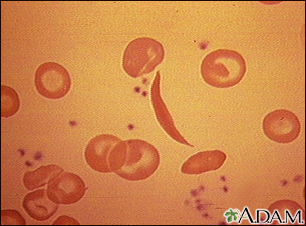
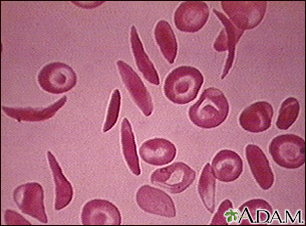
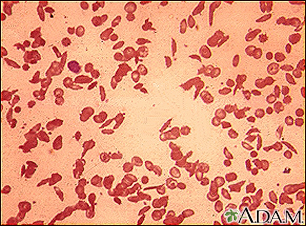
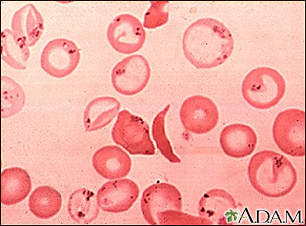
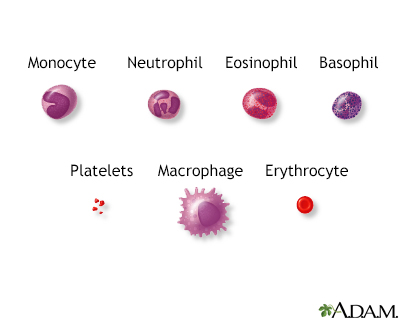
 All rights reserved.
All rights reserved.